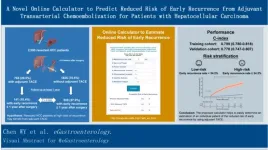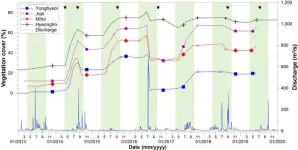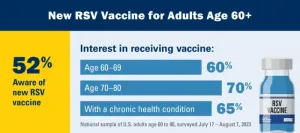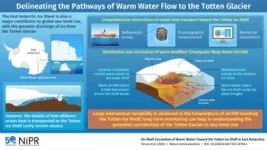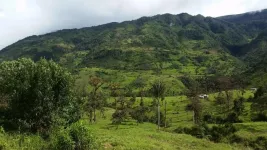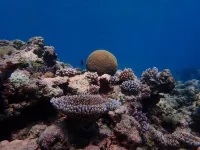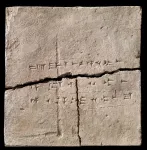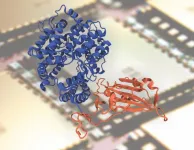(Press-News.org) Hepatocellular carcinoma (HCC) is the most commonly diagnosed cancer of the liver and the fourth leading cause of cancer-related mortality worldwide, with China accounting for over half of the global annual cases and deaths. Hepatectomy is the standard curative-intent treatment option for appropriately selected patients with localized HCC. However, the high postoperative recurrence rate causes many patients to have a poor prognosis and a high incidence of cancer-specific death. This occurs in especially early recurrence within the first year after surgery, which is most likely due to occult micro-metastasis from the original tumor. Given that survival among patients with recurrence is markedly worse than those without, there has been considerable interest in various neoadjuvant and adjuvant treatment approaches to prevent early recurrence following hepatectomy.
In a new paper published in eGastroenterology, a team of scientists led by Professor Tian Yang from Eastern Hepatobiliary Surgery Hospital and Professor Jian-Song Ji from Lishui Hospital developed a personalized calculator can be used as a predictive tool for estimating the reduced risk of early recurrence in HCC patients.
No treatment modalities have been widely adopted, and international guidelines recommend none. Identifying specific subsets of HCC patients who are at the highest risk of recurrence and who might preferentially benefit from adjuvant treatment to reduce recurrence, particularly for early recurrence within a short period after surgery, has been a topic of interest.
Transarterial chemoembolization (TACE) performed 4-8 weeks after hepatectomy is an adjuvant treatment used to reduce risks of postoperative recurrence and improve long-term prognosis. In theory, adjuvant TACE can eliminate occult micro-metastasis related to the original tumor, or residual tumors left after surgery, thereby preventing early recurrence after surgery.
Adjuvant TACE's impact in preventing post-hepatectomy recurrence remains controversial. Several single-center randomized controlled trials (RCTs) reported no benefit or decreased survival using adjuvant TACE. These disappointing results may be related to poor selection criteria. Only a recent comprehensive review on adjuvant TACE suggested that patients at high risk of recurrence benefited from adjuvant TACE.
There has been increasing interest in the development of cancer risk prediction models. These models can be helpful decision-making tools in clinical settings. Such tools may be more reliable than a personal clinical judgment about whether an individual may benefit from adjuvant therapy.
The research team sought to develop a prediction tool to identify HCC patients at high risk of early recurrence after curative hepatectomy. They also aimed to estimate the degree of risk reduction for early recurrence based on adjuvant TACE utilization at the individual patient level. The team developed an Internet browser-based decision calculator to help clinicians make decisions about adjuvant TACE after hepatectomy for HCC.
Postoperative adjuvant therapies predominantly eliminate a microvascular disease originating from the primary tumor or residual foci left after resection for malignant tumors. Adjuvant TACE may be more suitable for patients likely to develop early recurrence after hepatectomy for HCC. Recent randomized control studies (RCTs) and systematic reviews have indicated that adjuvant TACE was associated with improved long-term survival only in subsets of patients with one or more high-risk characteristics of HCC recurrence but not for patients with no high-risk features. Therefore, predicting individual patient risk of developing postoperative recurrence is of great importance in deciding whether to use adjuvant TACE for patients with HCC.
The study aimed to identify the personalized net benefit by reducing the risk of early recurrence associated with adjuvant TACE for an individual patient undergoing hepatectomy for HCC using a prediction model based on eight independent factors. The model demonstrated good discrimination and calibration, with C-indices greater than 0.75 in training and validation cohorts.
Based on this nomogram formula, a proposed online calculator was created to estimate the probabilities of early recurrence for HCC patients relative to receipt of adjuvant TACE. The difference between the two estimates being the expected benefit from adjuvant TACE. Based on the calculator, patients could be stratified into risk groups relative to early recurrence, which could also categorize the patient risk of CSS.
This model is the first prediction model to estimate the reduced risk of early recurrence from adjuvant TACE among individual patients undergoing hepatectomy for HCC. These data may help clinicians in decision-making about the potential role of adjuvant TACE among patients undergoing hepatectomy for HCC.
About the eGastroenterology
eGastroenterology is a new, open-access, and open peer-reviewed BMJ Journal, which focuses on basic, clinical, translational, and evidence-based medicine research in all areas of gastroenterology (including hepatology, pancreatology, esophagology, and gastrointestinal surgery).
For more information, please visit: egastroenterology.bmj.com and follow us on Twitter (@eGastro_BMJ).
END
Chestnut Hill, Mass. (8/22/2023) – In a breakthrough in liver transplantation that may lead to the ability to connect more living donors and patients, a new matching system designed by a team led by Boston College economists enabled the world’s first four-way liver exchange and a cascade of additional matches, researchers reported recently in the American Journal of Transplantation.
The results show that expanding the capacity of the donor-patient matching mechanism beyond the traditional 2-way change – matching two patients with two donors – can increase the number of ...
Researchers at the Korea Institute of Civil Engineering and Building Technology (KICT, President Kim Byung-suk) published their findings on the drastic short-term alterations in rivers accompanied by shifts in vegetation and geomorphology drawn from actual on-site investigation and analyses and not from model simulations.
The alteration processes from a 'white river,' characterized by riverbeds with no vegetation including bare sandbars, to a densely vegetated 'green river' with grass and trees, have been ...
COLUMBUS, Ohio – Train elementary school students how to be creative and you can help increase their resilience in the face of real-life problems, new research suggests.
In a small study, researchers trained third, fourth and fifth graders to use literary techniques such as perspective shifting, counter-factual (what if) thinking and causal (why) thinking to improve creativity in dealing with difficulties.
The techniques helped kids come up with new, creative and practical ways to solve problems, said Angus Fletcher, lead author of the study and a professor of English at The Ohio State University and member of the university’s Project ...
The first Americans over age 60 just started rolling up their sleeves to get vaccinated against respiratory syncytial virus, or RSV, now that brand-new vaccines have started to arrive at pharmacies and clinics.
Millions more older adults may do the same in coming weeks and months, a new University of Michigan poll suggests, as they seek protection against a virus that is especially good at infecting older lungs.
But nearly half of older adults do not know about the new RSV vaccines that received approval earlier this year, the poll finds. And some groups of older adults show much less interest in getting ...
PULLMAN, Wash. — A shipping container that can test passive cooling systems could help researchers and builders find carbon-free ways to keep people cool in extreme temperatures.
Washington State University researchers created the 60 square-foot chamber to test passive systems that use wind towers along with water evaporation instead of electricity to cool spaces.
Finding cooling methods that don’t require putting more greenhouse gases into the air is crucial to helping a growing population adapt to climate change, said Omar Al-Hassawi lead author of the study in the journal, Energies.
“Cooling is ...
One of the most feared effects of global warming is the rise in sea level caused by the melting of polar continental ice. In fact, polar researchers have been working towards raising the awareness of this impending threat. The scientific fraternity relies on sampling the remote regions of Artic and the Antarctic continental shelves to estimate these risks. They can then use these measurements to model and understand the processes that drive the melting of ice at these locations and determine the extent of meltwater that will eventually flow ...
Birds native to the tropical Andes, many of which cannot be found anywhere else, are threatened by increasing agricultural development in the region. A new study details how the resulting habitat loss affects specific species and lays out possible ways to protect birds from human-driven disturbance.
The researchers combined a meta-analysis of papers on birds across the Andes with five years of fieldwork in Peru, revealing that open farmlands result in up to a 60% decline in the number of species in an area. Before this work, there was little data on which species were declining or by how much.
“The vast majority ...
Coral reefs in one part of the Pacific Ocean have likely adjusted to higher ocean temperatures which could reduce future bleaching impacts of climate change, new research reveals.
A Newcastle University-led study focused on the Pacific Island nation of Palau and has shown that historic increases in the thermal tolerance of coral reefs are possible. The results demonstrate how this capacity could reduce future bleaching impacts if global carbon emissions are cut down.
Drawing on decades of field observations, the scientists modelled many possible future coral bleaching trajectories for Palauan reefs, ...
For the first time, a group of researchers have successfully extracted ancient DNA from a 2,900-year-old clay brick.
The analysis provides a fascinating insight into the diversity of plant species cultivated at that time and place, and could open the way to similar studies on clay material from other sites and time periods.
The results are published today in Nature Scientific Reports.
Currently housed at the National Museum of Denmark, the clay brick originates from the palace of Neo-Assyrian king Ashurnasirpal II, in the ancient city of Kalhu. Known today as the North-West palace in Nimrud (modern-day northern Iraq), its construction began around 879 BCE. ...
In a recently published article featured on the cover of the Biophysical Journal, Dr. Rafael Bernardi, assistant professor of biophysics at the Department of Physics at Auburn University, and Dr. Marcelo Melo, a postdoctoral researcher in Dr. Bernardi's group, shed light on the transformative capabilities of the next generation of supercomputers in reshaping the landscape of biophysics.
The researchers at Auburn delve into the harmonious fusion of computational modeling and experimental biophysics, providing a perspective for a future in which discoveries ...
